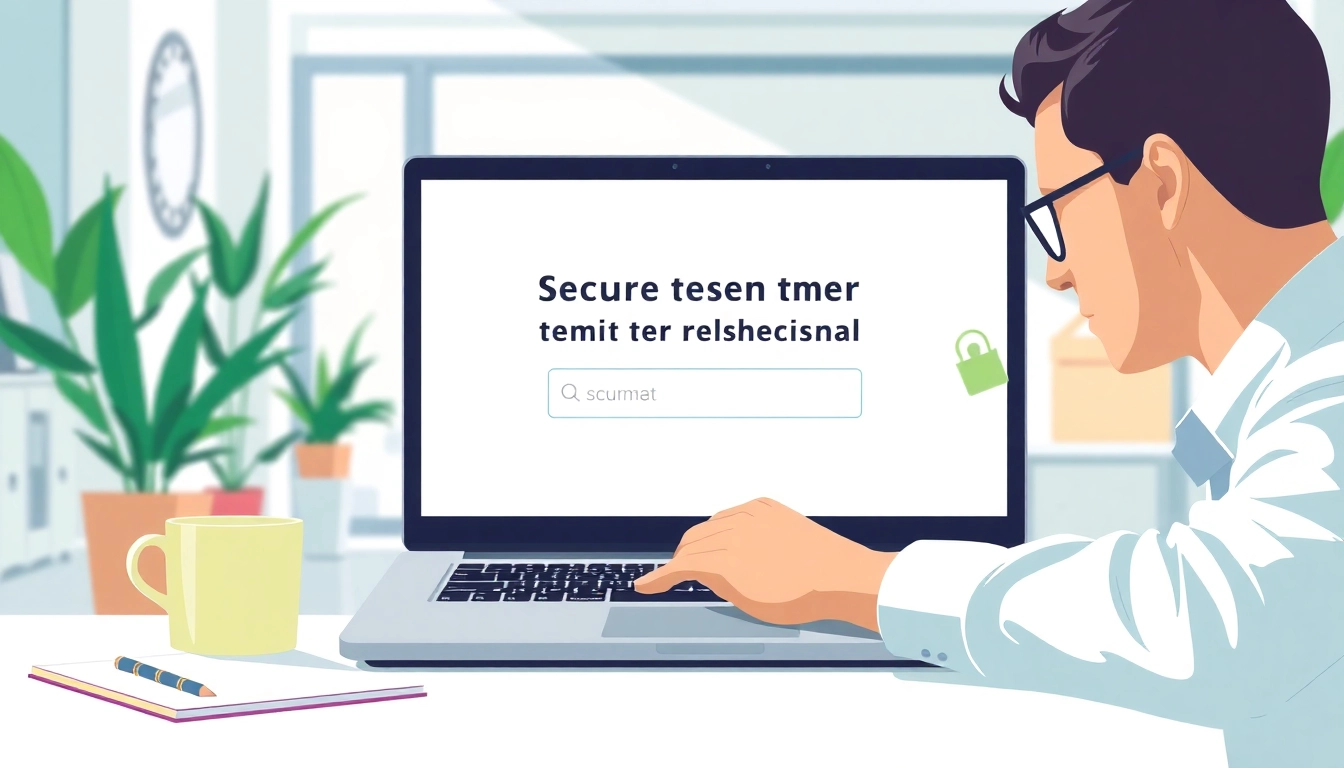Understanding Temporary Email
What is Temporary Email?
Temporary email, also known as disposable email, refers to a service that allows users to receive emails at an address that is valid for a short period. Essentially, these email addresses create a facade that facilitates interaction without revealing one’s personal email account. Users can generate a temporary email address to receive messages for a limited time, after which the address ceases to be functional. This method has gained significant popularity, especially in an age where data privacy concerns are skyrocketing.
Benefits of Using Temporary Email
There are numerous benefits associated with using a temporary email address:
- Privacy Protection: By utilizing a temporary email, users can keep their personal and work-related email accounts free from spam and unwanted communications. This allows users to maintain their privacy more effectively.
- Spam Reduction: Many websites and services often send promotional materials and junk mail. Using a temporary email address helps protect against these unsolicited queries.
- Convenience: Users can quickly create a temporary email account without any complex registration processes. This simplicity is attractive for quick sign-ups and resets.
- Anonymity: For those who wish to engage in conversations without revealing their identity, temporary email serves as a perfect tool.
- Security: With a temporary address, sensitive information can be sent without carrying the risk of compromising a personal email account.
Common Use Cases for Temporary Email
Temporary emails can be utilized in a variety of scenarios:
- Account Registrations: Many online services require email verification. Using a temporary email allows users to register without exposing their primary email address.
- Trial Services: Users can access free trials of various paid services while evading the obligation to provide a long-term email address.
- Feedback Forms: Organizations often seek feedback through email links. Temporary emails allow users to provide input without cluttering their primary inboxes.
- Downloading E-books or Resources: Many sites request an email address to download content. A temporary address can be a hassle-free solution.
- Online Shopping: When making purchases from lesser-known brands, a temporary email can help protect your main email from potential spam.
How to Create a Temporary Email
Step-by-Step Guide to Generating a Temporary Email
Creating a temporary email is a straightforward process that generally involves the following steps:
- Choose a Temporary Email Service: Look for reputable temporary email services that fit your needs.
- Select an Email Address: Most services allow you to choose your email address or generate one automatically.
- Access Your Inbox: Once created, users can instantly access their inbox through the service provider’s website, where they can view messages sent to the temporary address.
- Use the Email for Sign-ups: Utilize your new temporary email when registering for online services, downloading content, or any other necessary purposes.
- Monitor and Discard: Check your inbox for emails and, after use, the email address will become inactive after a set time – usually from a few minutes to several hours.
Best Practices for Choosing a Temporary Email Provider
When selecting a temporary email provider, consider the following:
- User Reviews: Look for feedback from other users regarding reliability and ease of use.
- Security Measures: Ensure that the service implements encryption and has policies in place to protect users’ data.
- Email Validity Length: Check how long the temporary email is valid, as some providers offer varying lifespans.
- Accessibility: Choose a provider that allows easy access to the inbox without complex verification processes.
- Functional Features: Some providers may offer additional features like email forwarding or custom domains.
Security Considerations When Using Temporary Email
While temporary emails offer anonymity and reduce spam, there are potential security concerns to be aware of:
- Phishing Attacks: Use caution when clicking links or responding to emails, as temporary accounts may be used by malicious entities.
- Data Exposure: Some temporary email providers may store email content longer than intended. Research your provider’s data retention policies.
- Accessibility to Others: Temporary emails can sometimes be accessed by other users if not provided with sufficient privacy protections; choose a reliable provider.
Comparing Temporary Email Services
Features to Look for in Temporary Email Services
When comparing different temporary email services, pay attention to specific features:
- Ease of Use: The registration process should be free of complications without needing to validate your information.
- Retention Policy: Understand how long emails and accounts will be stored and accessible before deletion.
- API Access: Some services offer API capabilities for users or developers looking to integrate temporary email functionality into their applications.
- Customization Options: Consider whether the service offers the option to customize your temporary email address.
- Multi-device Access: Ensure that the service works well across various devices and browsers, facilitating email access wherever needed.
User Experiences: Pros and Cons
While the advantages of temporary emails are evident, users may also experience some downsides. Here are common pros and cons:
Pros:
- No long-term commitments or obligations for personal accounts.
- Ideal for short-term interactions or transactions without personal data exposure.
- Quick access to inbox with fewer requirements.
Cons:
- Limited support available for issues that may arise.
- Potential challenges in retrieving important emails if overlooked.
- Dependence on the service’s reliability for successful deliveries.
Performance Metrics to Evaluate Temporary Email Services
It’s crucial to assess different temporary email providers based on measurable performance metrics:
- Email Delivery Rate: Measure how reliably the service delivers messages.
- Average Inbox Response Time: Observe how quickly messages appear in the inbox after sending.
- Account Accessibility: Test how effortlessly you can access and manage your emails and account settings.
- User Satisfaction Surveys: Conduct surveys or read existing reviews to gauge overall user experience.
Common Challenges with Temporary Email
Understanding Limitations of Temporary Email
Temporary emails do come with their limitations, particularly in specific use cases:
- Some services may impose bandwidth limits on the number of emails received.
- Not all temporary emails allow for the sending of messages, which can restrict their functionality.
- Some websites may block temporary email domains, limiting access to services.
Troubleshooting Common Issues
Users may encounter various issues while using temporary email services. Here’s how to address them:
- Not Receiving Emails: Ensure that the temporary email address you are using is still valid by checking the service’s retention policy.
- Email Delivery Delays: Check if the service is experiencing high traffic or temporary downtime, which can impact email delivery.
- Website Restrictions: In the case of registration issues, try different temporary email providers or create a new address with a different format.
Alternatives to Temporary Email for Temporary Communication
If temporary emails are not fulfilling your needs, consider these alternatives:
- Disposable SMS Services: If you require communication via mobile, consider alternative services that offer temporary phone numbers.
- Anonymous Chat Platforms: Utilizing platforms designed for anonymous communication can facilitate temporary discussions without revealing personal data.
- Secure Messaging Apps: Apps that prioritize encryption and privacy provide another layer of security for temporary communications.
Future of Temporary Email Services
Emerging Trends in Temporary Email Technology
The future of temporary email services looks promising, with developments on the horizon:
- Machine Learning Integration: Advanced algorithms can improve spam detection and user experience, ensuring that important emails aren’t lost.
- Increased Automation: Futures services may automate the generation and disposal of temporary addresses without user interventions.
- Personalized Temporary Email Services: Some services might allow customization based on user preferences, creating a unique experience.
The Role of Privacy Regulations in Temporary Email Use
As privacy laws become more stringent worldwide, temporary email services might also adapt:
- Compliance with Data Protection Laws: User data protection will be pivotal. Temporary email providers must ensure full compliance with local and international regulations.
- Enhanced Data Protection Features: Services may begin to incorporate stronger encryption protocols and greater transparency regarding data handling practices.
- Educational Initiatives: Providers may be tasked with educating users on how best to protect their personal information while utilizing temporary emails.
Innovations on the Horizon for Temporary Email Services
Finally, innovation will play a fundamental role in the evolution of these services:
- Blockchain Technology: Blockchain can potentially enhance the security of temporary emails, providing a decentralized approach to address management.
- Integration with Other Apps: Future solutions may link with various apps or sites, enhancing usability and the value of temporary email addresses.
- Voice Recognition Features: Voice-driven commands will streamline access and management of temporary emails, making it easier for users who prefer hands-free operations.

